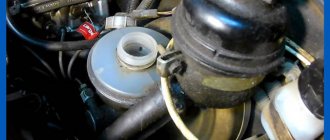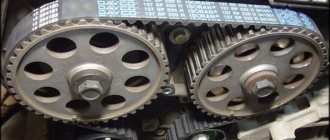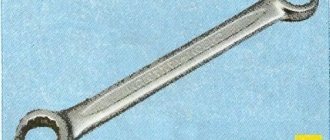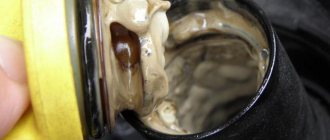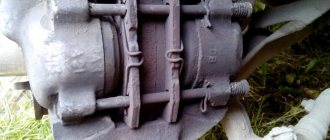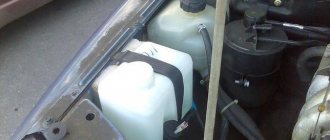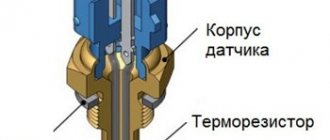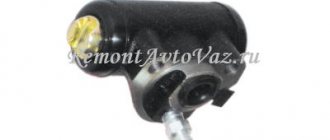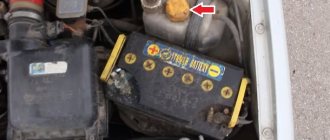The VAZ 2114 car is equipped with a brake system equipped with a hydraulic drive. The nuance is that the brake circuits are located diagonally.
Due to this design, if one of the circuits fails, the second one begins to work more efficiently, allowing the driver to brake in a timely manner. Three types of braking substance are used for the system:
- Dew;
- Rosa 3;
- Rosa DOT 4.
Design
The task of the driver and car owner part-time is to constantly monitor the condition of the brake system.
Failure of one of its elements can lead to serious consequences. Therefore, you should know what exactly is included in the braking system.
The components of the vehicle are:
- Brake fluid reservoir mounted on the GTZ;
- Metal pipelines of two circuits;
- Flexible brake hoses for front and rear wheels;
- GTZ (brake master cylinder located in the engine compartment);
- Brake cylinders of front and rear wheels;
- Pressure regulator;
- Brake fluid level sensor;
- Vacuum booster.
Tank with TJ
According to the recommendations of specialists, the replacement of the TZ is carried out once every 3 years, but at least once every 45 thousand kilometers.
Reasons for replacement
There are several characteristic malfunctions that must necessarily entail the replacement of the TJ.
- The presence of leaks from the brake cylinders, which lead to the loss of a large amount of fluid.
- The appearance of air pockets in the pipeline and hose system. They arise due to a leak in the brake system elements.
- Scuffs or deformation of flexible hoses installed on wheels. They also require replacement of the hoses themselves.
- Violation of the integrity of the sealing rings in the main brake cylinder, which leads to leakage of the working substance.
- Fluid leaking through the sealing ring of the pusher on the rear wheels.
- Violation of the tightness of the system circuit. This can be felt by a partially collapsed brake pedal.
- Mechanical failure of one of the elements of the braking system. In addition to repairing or replacing them, you will definitely have to change the TZ.
Choice of TZ
To choose the best option for a brake substance, you should take into account the main parameters of its selection so that it meets the requirements of the VAZ 2114 model. After all, this is the car we are talking about.
Having chosen the vehicle that is suitable for your car, you should replace it. It’s entirely possible to do the work yourself, but you should first read the instruction manual, consult with specialists, or watch visual video lessons.
Draining and bleeding process
How to find the cause of the leak
To find where the VAZ 2114 brake fluid goes, you should conduct a thorough visual inspection.
Brake hoses
The easiest way to detect a leak is on the brake hoses - here it is enough to check the rubber by touch. If it is rigid, inelastic and cracks form when bent, the hose must be replaced, even if there are no leaks.
Sometimes a brake hose of the wrong diameter falls off the fitting. In this case, it should be replaced with a similar one, but smaller in diameter. You can put on the same hose, but in this case you will have to secure it with special clamps.
Wheel brake cylinders
To detect fluid leaks on the brake cylinders, remove the wheels and inspect the brake system for signs of leakage on the calipers.
VAZ-2114 is equipped with a drum braking system. To detect leaks in the wheel cylinders, the brake drums must also be removed. This usually causes difficulty in removal due to the fact that their surface wears out.
In this case, they are removed in two ways:
- You can “squeeze” the drum out of the hub by selecting bolts of the required diameter and screwing them into the threaded holes on the drum. This is done until the drum is removed.
- Knock out the brake drum by hitting its internal parts with a hammer from opposite sides.
Important! With the second method, you should only use a hammer with a rubber striker. Metal cannot be used, because The drum may be damaged.
The best option for the VAZ-2114 is to replace the entire brake cylinder assembly at once. Otherwise, you should disassemble the cylinder and inspect its parts for damage.
You need to carefully examine:
- the surface of the cylinder itself;
- pistons - need to be changed if there are signs of corrosion or scratches on them;
- seals - if worn or in case of a loose fit, they should be replaced;
- Anthers - check for rips, scratches, cuts and other damage.
Attention! Before assembly, all cylinder parts should be cleaned and washed with brake fluid.
Replacement
To replace the TJ yourself, you will need a certain set of tools and materials. This set includes:
- Brake fluid - 500 millimeters;
- A set of keys;
- Screwdriver Set;
- Transparent flexible hose;
- Container for draining old fluid;
- Dry rags for cleaning surfaces.
To work, you will definitely need the help of one more person, so when pumping, one should be inside the car, and the other outside.
Let's start the procedure.
- Unscrew the cap on the master cylinder reservoir and place it on a prepared surface. The cover is combined with the float of the fuel oil level sensor, so be careful, because a toxic and dangerous substance will remain on it.
- Unlock the rear brakes using a screwdriver. It is simply inserted between the plate and the piston. Ready.
Inserted a screwdriver
- Clean the right rear brake release valve of any accumulated dirt and dust, then remove the rubber cap that covers the valve.
- Place a flexible transparent hose onto the valve fitting and place its other end in a container to drain the liquid.
- Approximately once every two seconds, press the gas pedal all the way four times in succession. When you press the fifth time, lock the pedal in the clamped position.
- Unscrew the valve at least half a turn. As the brake fluid drains, the pedal will gradually begin to sink.
- As soon as the fluid flow stops, close the valve.
- Simultaneously with the procedure, do not forget to monitor the level of fuel fluid in the tank.
- As you pump out the old substance, add a little new one. This will avoid the formation of air locks inside the system.
- Add fresh fuel fluid into the tank until all the old fluid comes out and new clean substance begins to flow through the hose into the container.
- Having completed the work on the rear right wheel, go to the front left and perform a similar procedure. Due to this movement pattern, you will be able to completely get rid of the old fuel oil in one circuit.
- By analogy, remove the fuel fluid from the second circuit in the same sequence. Having completed draining, close the valves with caps and add new fuel fluid to the required level.
Accuracy comes first
After completing the replacement procedure, be sure to bleed the brakes. It is strictly not recommended to go out on the road without it, since the brakes may simply not work.
Why bleed the brakes?
Bleeding a vehicle is a preventive measure aimed at ensuring stable operation of the brakes. The point is to remove foreign liquid and excess air.
Air and excess liquid can appear in the system for various reasons. Namely:
- The hoses are damaged and their integrity is compromised;
- Low-quality brake substance is used;
- System elements were replaced or brake fluid was updated;
- The seal of the vehicle is broken.
Any braking system, due to its design, can spontaneously accumulate moisture inside itself. Therefore, pumping cannot be ignored under any circumstances.
Leveling up
In fact, you can bleed the brakes on your own, and sometimes there is even no other way out. First, we recommend watching a training video in which you will be able to clearly study all the nuances of the procedure.
Important rule. Do not add new fuel fluid to the system if it does not match the composition of the old substance.
Make sure that everything is good with the vehicle’s tightness, so that the work is not done in vain.
If you have just finished replacing your vehicle, do not rush to let your friend go home. You will also need it at the pumping stage.
Press the pedal to the floor
The brakes need to be bled in a certain sequence:
- Right rear brake.
- Left front brake.
- Left back.
- Right front.
We begin the pumping procedure.
- Check the brake fluid level in the reservoir. Before pumping, it must be as full as possible;
- Clean the outlet valve from any contaminants present there;
- Remove the protective cap from the valve, and before that fill the glass container with the working substance - TJ;
- Take a rubber hose and place it on the valve head;
- Place the other end in a container with TJ. This is a homemade device for pumping, which is not inferior in efficiency to professional equipment at car service stations;
- Approximately five times with a break of 2 seconds, press the brake pedal all the way;
- After making the last press, lock the pedal to the floor;
- Unscrew the valve 75 percent;
- Liquid with bubbles will begin to flow from there;
- As soon as the flow stops, you can close the valve;
- After closing the valve, release the pedal;
- Repeat steps 5-7 at least one more time. More bleeding cycles may be required. Your task is to ensure that there are no air bubbles when the liquid flows out;
- As the fuel fluid flows out, be sure to add it to the tank, maintaining it at the maximum level;
- Having completed pumping, remove the hose, remove all traces of fuel fluid from the fitting and screw on the cap.
Despite the abundance of stages, in practice the work does not take much time. But by replacing and pumping the vehicle yourself, you can significantly save on car service costs.
The VAZ 2114 car is equipped with a brake system with a hydraulic drive. A special feature of the vehicle on this machine is the diagonal distribution of the brake circuits. If one of them fails, the second provides braking with high efficiency. The working substance for vehicles is brake fluid VAZ 2114 “Rosa”, “Rosa-3”, “Rosa-DOT-4”.
How to choose?
The most important thing when buying is not to run into a fake: they may sell you ordinary colored water, acid, fresh water with sediment, etc. Naturally, the braking properties of fakes do not reach the standards, if they have brakes at all.
Of the Russian ones, it reaches the level of DOT 4, “Neva” and “Tom” - DOT 3. If you have a penchant for aggressive sports driving, then it is better to take a closer look at foreign manufacturers who also mark brake fluid in DOT categories, except Shell and Total. Shell has: TJ (brake fluid) Donax ZB - meets the requirements of DOT 5.1, and YB - DOT 4.
For normal civilian driving, the Russian RosDot Rosa 4 is also suitable.
How often do you change brake fluid? Do not forget that brake fluid has its service life and requires replacement.
Replacing brake fluid on a VAZ 2114
The VAZ 2114 car is equipped with a brake system with a hydraulic drive. A special feature of the vehicle on this machine is the diagonal distribution of the brake circuits. If one of them fails, the second provides braking with high efficiency. The working substance for vehicles is brake fluid VAZ 2114 “Rosa”, “Rosa-3”, “Rosa-DOT-4”.
Replacing brake fluid VAZ 2114
Vehicle malfunctions leading to replacement of the vehicle with a VAZ 2114
The hydraulic brake system includes many different parts that allow you to operate the brakes using hydraulic fluid. It includes:
- a tank that is attached to the gas turbine engine and is intended for filling the fuel fluid;
- metal pipelines of both circuits;
- flexible brake hoses of front and rear wheels;
- GTZ installed in the engine compartment;
- working brake cylinders of front and rear wheels;
- dual-circuit pressure regulator;
- a sensor showing at what level the fuel fluid is located;
- a vacuum booster, the task of which is to create working fluid pressure in the pipelines of the circuits in order to ensure effective operation of the brake systems on the wheels during braking.
A car’s vehicle is one of the main systems that ensures the safety of the driver and passengers of the car, therefore regular preventive inspection of all elements of the vehicle is mandatory for the owner of the car.
The brake fluid on the VAZ 2114, according to the recommendations of technical specialists, is replaced every three years or no more than after 45 thousand kilometers of the vehicle.
At the same time, during the operation of a vehicle, malfunctions periodically occur in its braking system and especially in the hydraulic drive, leading to the need to replace the brake fluid. Knowledge of these malfunctions and the reasons leading to them can help the driver avoid serious troubles on the road, since in this case he can promptly identify the failure and take measures to eliminate it.
Malfunctions in the vehicle resulting in the need to replace the vehicle:
- Leaks from the working brake cylinders leading to significant loss of fuel fluid.
- The formation of air pockets in main pipelines and flexible hoses, which are formed as a result of leaks in vehicle units.
- Rupture or fraying in the flexible hoses on the wheels, in this case the brake hoses on the VAZ 2114 need to be replaced. Damage to metal pipelines is also possible; as a rule, a leak forms due to “chasing”. In both cases, the liquid quickly flows out of the vehicle, so at the slightest sign of disorder in the vehicle, these parts should be checked first.
- Damage or swelling of the sealing rings in the GTZ or wheel cylinders. This also leads to leaks.
- Leakage of fuel fluid through the sealing rings of the rear wheel RD pusher.
- There may be a leak in one of the brake circuits. In this case, partial failure of the brake pedal occurs.
- Quite rarely, but metal pipelines become clogged.
- As a result of mechanical damage, failures of the GTZ, RTC, vacuum unit and other vehicle elements are possible. To eliminate these damages on the VAZ 2114, replacing the brake fluid is a prerequisite.
Recommendations for servicing the brake circuit of the VAZ 2114
- Conduct scheduled technical inspections of the vehicle in a timely manner;
- When purchasing, carefully check the catalog numbers with the data specified in the instruction manual;
- Use the services of certified points of sale.
Service station experts recommend purchasing DOT-4 on semi-synthetic and synthetic bases. It is “synthetics” that meets many modern requirements and quality standards.
Mineral-based lubricants are not always effective for high speed conditions and systematic loads. If you have any difficulties choosing a technical vehicle for a VAZ 2114, contact service station specialists and auto store managers for help.
Replacing brake fluid on a VAZ 2114
VAZ 2114 has a hydraulic brake system. How to install the ignition on a VAZ 21099: a step-by-step guide to adjusting the ignition on different types of engines (carburetor. A special feature of the car on this car is the diagonal distribution of the brake circuits. brake fluid VAZ 2114 “Rosa”, “Rosa-3”, “Rosa-DOT-4” "
VAZ 2114 brake fluid replacement
Car malfunctions that lead to replacing the TG with a VAZ 2114
The hydraulic actuator that provides brake sensing (software) means many different parts that allow the hydraulic fluid to be used to activate the brakes. How to remove the dashboard and instrument cluster from VAZ VAZ 2112) How to remove 2114 VAZ 2115 VAZ 21099. It includes:
- tank attached to the GTZ, not intended for filling the TZ;
- iron pipelines of both circuits;
- flexible front brake hoses, not rear wheels;
- Installed under the hood of the GTZ;
- working brake cylinders of the front, not the rear wheels;
- dual-circuit pressure regulator;
- a sensor showing what level the TJ is at;
- a vacuum booster, the purpose of which is to create operating water pressure in the pipelines of the circuits to ensure effective operation of the braking systems in motion during braking.
A vehicle is one of the main systems that ensures the safety of the driver, and not the passengers of the car, so constant preventive inspection of all parts of the car is inevitable for the car owner.
Replacing brake fluid on a VAZ 2114, according to the recommendations of technical experts, is carried out every three years or no more than 45 thousand kilometers.
When using a vehicle, its brake system, especially the hydraulic drive, sometimes develops problems that lead to the replacement of the TJ. The main purpose of the tachometer on the VAZ 21099 carburetor is how to connect a tachometer. Knowing these defects, rather than the circumstances of this top list, helps the driver avoid serious problems on the road, since he or she can detect the problem until they take action to fix it.
There is a malfunction in the vehicle, so a replacement TJ needs to be created:
- Leakage from the service brake cylinders results in a significant loss of TA.
- Formation of air accumulation in main pipelines from hard hoses resulting from leaks in vehicle components.
- Hurry differently, break the flexible hoses while moving, then you need to replace the brake hoses on the VAZ 2114. How to disassemble the doors of the VAZ 2114 and remove the linings? Damage to iron pipelines is also possible due to "chase". In any case, the fluid quickly flows out of the car, so at the slightest sign of trouble in the car. these parts must be checked first.
- Damage to another O-ring seal in the GTZ, in other words, the wheel cylinders. The steps when replacing brake fluid on a VAZ 2114 are the same as when bleeding the brakes, only in this case the old brake fluid is not removed from the system, and not from the air. This also leads to leakage.
- TJ leakage through the rear wheel pushrod ring seal.
- For you, a violation of the density of the textbook from the brake chains. How can you install a turbine to install a turbine on a VAZ; on the VAZ 2107 2106 2101 engine. This is a partial malfunction of the brake pedal.
- Quite often, but iron pipelines are clogged there.
- After mechanical damage, GTZ, RTT, and the vacuum chamber of other parts of the vehicle may malfunction. To repair these damages on the VAZ 2114, it is necessary to replace the brake water.
replacing brake fluid
replacing VAZ Brake fluid
-2111.
Changing the brake fluid itself
Addressing this problem, Technical Environment, its presenter Gennady Emelkin will say that without the help of others it will change.
Selection of brake fluid and procedure for replacing it on a VAZ 2114
For vehicle operation with the highest efficiency, it is important for motorists to choose the right working fluid to drive the hydraulic brake. Modern TJs, such as Rosa, but not its variants, contain polyglycols that make up 93 to 98 percent of the total. Today we have a VAZ 2108, 2109 car service. It was decided to change this. Therefore, in people like him. Replacing thresholds on a VAZ 2114 Removing rust on a car door How to remove rust. Rest. various additives necessary for adhesion to snowflakes during the oxidation of fuel oil to prevent corrosion of the iron parts of the car.
When purchasing a TJ, you need to pay attention to the following characteristics:
- The boiling point, like that of oil, should be high to reduce the likelihood of steam bubbles forming;
- excellent viscosity, which characterizes the ability to pump water into the system;
- ability to absorb water, naturally hygroscopic;
- ability to lubricate internal surfaces;
- neutrality towards rubber parts, allowing (braking) braking to be taken into account;
- Oxidation resistance is not the ability to prevent corrosion.
In the TJ class for the VAZ 2114, DOT 3 is marked.
How to change the brake
fluid for VAZ 2114. For the correct actions, you need to carefully study the operation of the car.
Before you start, you need to prepare the appropriate tool, not materials:
- TG in the amount of 0.5 l;
- keys are not screwdrivers;
- transparent flexible hose;
- container for draining waste fuel oil;
- a cloth for wiping surfaces, especially plastic ones, that do not get dirty, since the liquid is toxic and not aggressive to these surfaces.
To replace the TJ, you need to lure a helper because it requires bleeding, which allows the (software) monitoring of the brake pedal.
- On the GTZ side, open the lid and do not place it on the prepared surface. The cover is combined with the TJ level float; he has the remains of the old poisonous TJ.
- Unlock the brake disc using a screwdriver that must not be inserted between the piston plate.
- Do not remove dirt from the right rear brake release valve. Do not unscrew the rubber cap covering the mythical valve.
- Place a flexible hose, previously inserted into a transparent container, over the connection of this valve.
- At two-second intervals, press the pedal four times in the full program, 5th press, lock it in the pressed position.
- Unscrew the valve more than half a turn. How to improve headlights on a VAZ 2114. During a rainstorm, the TJ pedal should fail. How to bleed the brakes on a VAZ 2114 (video) etc. When the liquid does not leak, close the air valve immediately.
- During these stages, it is necessary to monitor the water level in the tank, constantly adding water to prevent air build-up. There is no need to add until the liquid has flowed out, until completely new, flawless liquid flows out of the tube.
The problem of brake fluid leakage has affected many car enthusiasts. If brake fluid leaks on a VAZ 2114 and other cars, you must first identify “weak spots” - where the fluid can go.
Selecting brake fluid and the procedure for replacing it on a VAZ 2114
For the normal functioning of the vehicle’s vehicle with maximum efficiency, it is important for the car owner to correctly select the working fluid for the hydraulic brake drive. Modern TG, such as “Rosa” and its varieties, are based on polyglycols and this accounts for from 93 to 98 percent of the total composition. The rest is various additives that are necessary to combat oxidation of fuel fluid and prevent corrosion of metal parts of the vehicle.
When purchasing a vehicle, you need to pay attention to the following parameters:
- boiling point, it should be high to reduce the likelihood of plug formation from steam bubbles;
- good viscosity, which characterizes the ability to pump liquid in the system;
- the ability to absorb water, that is, hygroscopicity;
- ability to lubricate internal surfaces;
- neutrality in relation to rubber parts of the braking system;
- oxidation resistance and corrosion resistance.
According to the TZh class for the VAZ 2114, they are marked DOT 3.
How to change the brake fluid on a VAZ 2114 - for the correct actions you need to carefully study the car’s operating manual.
Before starting work, you need to prepare the necessary tools and materials:
- TJ in the amount of 0.5 liters;
- keys and screwdrivers;
- transparent flexible hose;
- container for draining spent fuel oil;
- rags to wipe surfaces, especially plastic and painted ones, since the liquid is toxic and aggressive to these surfaces.
To replace the turbocharger, you need to hire an assistant, because it requires bleeding the system using the brake pedal.
Welcome, friends, to the DIY car repair website. After long-term operation, all fluids used on the car must be changed and brake fluid is no exception.
The timing of replacement depends on the functions of the fluid itself. You can find out this period in the operating manual for a specific car brand.
Brake fluid is replaced on average once every 3 years, which corresponds to a mileage of approximately 45-50 thousand kilometers. A little later, the antifreeze is replaced, which also needs to be remembered.
Brake fluid tends to absorb moisture, that is, scientifically speaking, it is hygroscopic. The proportion of moisture in it is of course minimal, but still, over time, the substances that are included in it lose their properties.
Let's look at an example, let's say fresh TJ (DOT-4) has a boiling point of 240 degrees Celsius, and the old one, which contains some moisture, already has a boiling point of about 155 degrees, which is significantly lower than new or fresh liquid.
These are, of course, approximate values; much depends on the type of liquid, but still, the boiling point of old liquids is significantly reduced, which can lead to failure of the brake system and safe driving of the vehicle.
Mixing brake fluids is also not recommended. The manufacturers that make them use completely different standards and features.
Nowadays, most modern cars use brake fluids of the DOT-4 type; it is perfect for both drum and disc brakes.
Volume of fluid in the brake system
Basically, the brake system holds from 0.55 to 1.0 liters of fluid, this depends both on whether the car has an ABS system and on the size of the car. The period for replacing brake fluid in most cars is 2-3 years of use, or 40-60 thousand mileage . To determine a more specific interval, you need to look at a specific fluid standard and driving characteristics. For example, in sports cars the TZ is changed every 5-10 thousand.
But since the question of the required volume of brake fluid in the system and its standard is asked only by owners of ordinary cars, and not premium or business class ones, we will give specific examples for cars popular in the CIS countries.
What and how much brake fluid is in some cars
| Table of the volume of brake fluid required for replacement | ||
| car model | DOT class | Required amount of fuel fluid, l |
| Ford Focus 2 | DOT4 | 1 |
| Ford Focus 3 | DOT4 | 1 |
| Ford Kuga | DOT4 | 1 |
| Chevrolet Niva | DOT4 | 1 |
| Chevrolet Cruze | DOT4 | 1 |
| Chevrolet Lacetti | DOT 4 | 0.5 a with ABS and ESP 1.0 |
| Kia Sid | DOT4 | 1 |
| Kia Rio 3 | DOT4 | 1 |
| Kia Rio 2 | DOT 4 | with ABS - 1-1.5 l without - 1 l |
| Kia Sorento | DOT 5.1 | 1 |
| Kia Spectra | DOT3, DOT4 | 1 |
| Renault Logan | DOT 4 | with ABS – 1-1.5 l without – 0.7 l |
| Renault Duster | DOT4 | 1 |
| Renault Fluence | DOT4 | 0,5-1 |
| Renault Sandero | DOT4 | 1 |
| Renault Megane 2 | DOT4 | 1 |
| VAZ 2107, 2109 | DOT 3 | 0,55 |
| VAZ 2114, VAZ 2115 | DOT 4 | 1 |
| VAZ 2108, 2110, 2112 | DOT 4 | 1 |
| Lada Kalina | DOT 4 | 1 |
| Lada Priora (VAZ 2170) | DOT 4 | 1 |
| Lada Granta | DOT 4 | 1 |
| Lada Largus | DOT 4+ | 1 |
| Daewoo Matiz | DOT 4 | 1 |
| Mitsubishi Pajero 4 | DOT 4 | 1 |
| Mitsubishi Lancer IX | DOT 3, DOT 4 | 1 |
| Mitsubishi Lancer 10 | DOT 4 | 1 |
| Mazda Demio | DOT 3, DOT 4 | 1 |
| Mazda 3 | DOT 5.1 | 1 |
| Mazda cx 5 | DOT 4 | 1 |
| Skoda Superb II | with ABS DOT 4 | 1 |
| SKODA Octavia A5 | DOT 4 | 1 |
| Toyota RAV4 | DOT 3, DOT 4 | 0,5 |
| Toyota Corolla | DOT 4 | 1 |
| Toyota Prado 150 | DOT 4, DOT 5.1 | 1,5-1,6 |
| Volkswagen Polo sedan | DOT 4 | 1 |
| Daewoo Nexia | DOT 4, DOT 5.1 | 1 |
| Hyundai Solaris | DOT 4 | 1 |
| Hyundai Accent | DOT 5.1 | 1-1,5 |
| Volvo XC70 | DOT 4+ | 1 |
| Nissan Tiida | DOT 4 | 1 |
| Nissan Qashqai | DOT 4 | 1 |
| Nissan X Trail | DOT 3, DOT 4 | 1 |
How much brake fluid is in the VAZ system
VAZ cars are filled with brake fluid of the DOT-4 , but its amount in the brake system can be from 550 ml in a classic (VAZ 2107) to 1.0 liters in more modern domestic cars, such as VAZ 2110 or Kalina . But if you replace the TJ with flushing, then you should take 1.5 liters, and since there is no such packaging, you will have to buy two liter bottles.
How often to change brake fluid
Useful recommendations on how often to change the brake fluid in a car. Regulations on the frequency of changing brake fluid. More details
How to bleed the brakes
To properly bleed the brakes, you need to know the bleeding procedure specified by the car manufacturer. However, such mistakes should not be made. More details
Bleeding the brakes without an assistant
Bleeding your brakes can be a challenging task at times. But there is a simple way to do it without an assistant. See instructions for bleeding your car's brakes yourself. Learn more.
Why change brake fluid?
Yes, because everything has its own resource. Brake fluid is designed to transfer energy from the brake cylinder to the brake pads. If something does not function, the force transmitted to the pads will be significantly less.
This in turn can lead to brake failure. Also check out the website's materials on replacing brake pads. The factory provided for all this before us. You just need to follow the advice of experts to be confident in your safety on the road.
There are two answers to the question of how to change brake fluid. First, you need to contact a service station, where specialists will do everything using special equipment. The cost of the procedure is not high, and the process takes no more than a couple of hours.
The second answer would be to replace the brake fluid yourself. It's not difficult, you just need to follow the right sequence. But first, you need to check whether the fluid requires replacement.
Attention! When replacing fluid and bleeding the brake system, be careful not to accidentally get fluid into your eyes.
You can check the brake fluid using a special tester. You can find different types of these diagnostic devices in the market. The principle by which the state of a liquid is determined is the same.
The device calculates the boiling point of the liquid; if it is 175 degrees or more, then it means replacement is not needed. If it is below 165, replacement is required.
Replacing brake fluid on VAZ 2113, VAZ 2114, VAZ 2115
Welcome! Brake fluid - and it’s the only thing that slows down the car, although not everyone knows this, but in fact, only this fluid stops your car when you are rushing at high speed and you need to stop quickly. From what you read above, you understood that brake fluid is very necessary for a car, because if it weren’t for it, the car would not be able to be stopped at all (Not counting the hand brake, it only works by hand, that is, mechanically, and brake fluid for it is not needed at all), so this liquid must be changed periodically, since any liquid ages and thereby loses its properties.
Replacing brake fluid
If a replacement is needed, then you should study the structure of the brake system of your vehicle. Changing ABS brake fluid is very different.
Suppose without an ABC or a hydraulic accumulator, the pump and the ABC hydraulic valve block are located in one unit, then you can replace the fluid with your own hands. With integral ABC, it would be more correct to go to a service station.
Work must be carried out on each circuit of the brake system. The tools you will need are an empty bottle and a flexible hose. Additionally, you need to have a set of keys to work.
It all starts with the wheel that is furthest from the brake cylinder. First you need to drain the fluid from the brake reservoir and pour new one into it. Next, unscrew the fittings on each brake cylinder and wait until the old brake fluid drains out.
When a new one starts to leak, tighten the fitting. If the car has a diagonal system of contours, the process must begin with the right rear wheel, then the left front, then the rear left, and finally the front right.
With a parallel circuit, the sequence is:
- Right rear.
- Left rear.
- Right front.
- Left front.
Replacement must be carried out on removed wheels. If there is a hole, the work will be much easier. As a last resort, you can do all this with a jack, removing the wheels one by one.
At the same time, you can visually check the condition of the car, check the suspension elements and shock absorbers.
Be sure to bleed the brakes after all work. Look in the reservoir; you may need to add new fluid.
It is necessary to check the effectiveness of the brakes after replacing the brake fluid. We carry out the test on a dry road at various speeds. The car should stop smoothly and maintain directional stability. Have a good trip and no breakdowns.
